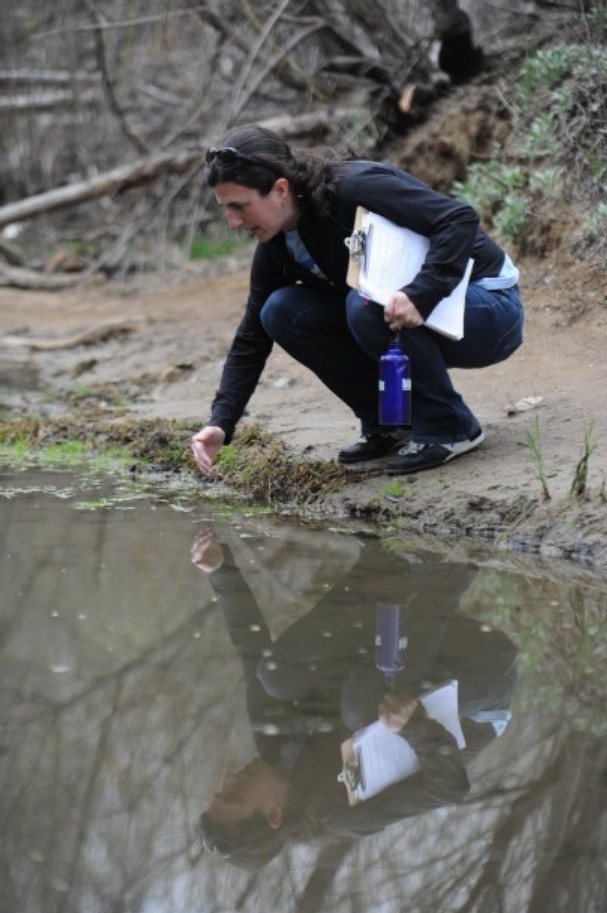We Won: Pollution Limits in Malibu Creek Upheld
Feb. 05, 2016 — Staff watershed scientist Katherine Pease bugs out about our major legal victory in Malibu Creek.
In May 2013, I stood in front of a packed meeting room in Agoura Hills, filled with West Valley residents concerned about rumors of rate increases from their local water district. My job was to convince them to care about aquatic bugs as much as their water bills. Needless to say, I faced an uphill battle.
Well, two years later, I’m proud to say that the bugs won.
This week a federal court upheld pollution reduction requirements created by the EPA – and informed by data collected by Heal the Bay scientists – to protect creatures both large and small in impaired Malibu Creek.
Back in 2013, the federal EPA established a formal Total Maximum Daily Load (TMDL) – basically a numeric pollution reduction requirement – to address the fact that Malibu Creek, some of its major tributaries, and Malibu Lagoon had very poor or impaired biological communities.
 Biological communities in streams are assessed through the different types and numbers of aquatic bugs (or benthic macroinvertebrates) that live there. Think of snails, worms, crayfish, and larval stages of dragonflies, damselflies, black flies, and mayflies. Which brings us back to why we or anyone should care about bugs.
Biological communities in streams are assessed through the different types and numbers of aquatic bugs (or benthic macroinvertebrates) that live there. Think of snails, worms, crayfish, and larval stages of dragonflies, damselflies, black flies, and mayflies. Which brings us back to why we or anyone should care about bugs.
Benthic macroinvertebrates are relatively stationary, ubiquitous, and they show a diversity of responses to stressors, making them an ideal indicator group of biological health. The biological condition of a stream tells a meaningful and comprehensive story of the condition of the stream’s water quality and habitat. A stream’s benthic macroinvertebrate community provides insights into its ecology, incorporating the effects of many factors that are difficult or impossible to replicate in a laboratory setting.
In essence, these bugs are an excellent indicator for the overall vibrancy of the stream.
For example, is the stream filled with only bugs that can tolerate polluted water? Or, is there a diversity of bugs that are sensitive to pollution in the creek? Healthy streams mean healthy watersheds, and healthy watersheds mean healthy cities.
The TMDL identified two main factors impairing the biological communities: high levels of nutrients and sediment. EPA came to that conclusion after completing a careful scientific analysis of water quality and biological data from the Malibu Creek Watershed.
One of the major sources of data came from Heal the Bay’s Stream Team. Since its inception in 1998, Heal the Bay citizen science volunteers and staff have been collecting water quality data monthly and conducting biological assessments yearly (since 2000) in the Malibu Creek Watershed.
These data helped to identify specific problems with the biological community and their sources. Sediment and nutrients both create poor habitat for aquatic bugs. Sediment blankets the stream bottoms, choking out prime habitat and diversity. Nutrients like phosphorous and nitrogen cause excess algal growth, which also can impair stream bottoms. (You can read more about these challenges and our proposed solutions in our detailed study here.)
The Tapia Water Reclamation Plant, which treats wastewater and discharges the treated water to Malibu Creek, has been a significant source of nutrients to Malibu Creek. While the effluent generally meets a high standard and contains low bacteria counts, the treated water still contains high levels of nutrients, specifically nitrogen and phosphorus.
The operators of the Tapia plant (the Las Virgenes-Triunfo Joint Powers Authority or JPA) objected to the new pollution limits and sued EPA to nullify the TMDL in the fall of 2013. As part of its challenge, the JPA questioned EPA and Heal the Bay’s science. They also argued that the costs of lowering nutrient levels in treated wastewater would be excessive. Because of the importance of the TMDL, Heal the Bay and our environmental partners NRDC and LA Waterkeeper intervened in the lawsuit, supporting the EPA.
We are very happy to report that this week that the TMDL has been upheld in court, thanks to good science and strong legal representation by NRDC.
We stand behind the science informing this important pollution limit, and we are proud that Stream Team data contributed to this process, which will ultimately improve the water quality and biological communities of our local streams and lagoons.
While the financial costs of protecting local streams need to be weighed carefully, we also need to weigh the environmental costs of not acting to preserve healthy watersheds – and what that means for water quality and wildlife that use the streams, including humans.
We should be creative in thinking about our water future, and how water quality and water supply are connected. In this time of drought, there are financially and environmentally strong investments in technology, like water recycling, which will reduce discharge to creeks, clean up water pollution, and help enhance our local water supplies.
Thankfully, the JPA is evaluating increasing water recycling as an option for the future health of Malibu Creek and local residents. This win is also a reminder that even though they may seem small and insignificant, aquatic bugs loom large. They tell us important information – like whether you can drink the water in your local stream, swim in it or eat the fish in it – if we just pay attention.
Photograph of the author courtesy of the Ventura County Star


